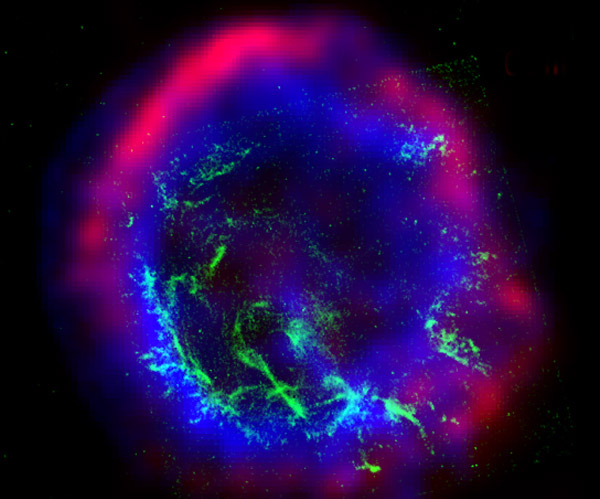
|
Explanation: Not all stars form a big Q after they explode. The shape of supernova remnant E0102-72, however, is giving astronomers a clue about how tremendous explosions disperse elements and interact with surrounded gas. The above image is a composite of three different photographs in three different types of light. Radio waves, shown in red, trace high-energy electrons spiraling around magnetic field lines in the shock wave expanding out from the detonated star. Optical light, shown in green, traces clumps of relatively cool gas that includes oxygen. X-rays, shown in blue, show relatively hot gas that has been heated to millions of degrees. This gas has been heated by an inward moving shock wave that has rebounded from a collision with existing or slower moving gas. This big Q currently measures 40 light-years across and was found in our neighboring SMC galaxy. Perhaps we would know even more if we could buy a vowel.
|
January February March April May June July August September October November December |
| ||||||||||||||||||||||||||||||||||||||||||||||||
NASA Web Site Statements, Warnings, and Disclaimers
NASA Official: Jay Norris. Specific rights apply.
A service of: LHEA at NASA / GSFC
& Michigan Tech. U.
Based on Astronomy Picture
Of the Day
Publications with keywords: radio - supernova remnant - shock wave - supernova
Publications with words: radio - supernova remnant - shock wave - supernova
See also:
- Supernova Remnant Cassiopeia A
- APOD: 2025 January 8 Á Supernova Remnants Big and Small
- APOD: 2024 September 18 Á The Mermaid Nebula Supernova Remnant
- APOD: 2024 April 16 Á Filaments of the Vela Supernova Remnant
- APOD: 2024 April 3 Á Unusual Nebula Pa 30
- APOD: 2024 March 25 Á Sonified: The Jellyfish Nebula Supernova Remnant
- APOD: 2024 February 27 Á Supernova Remnant Simeis 147
